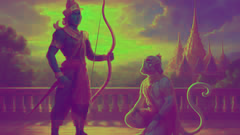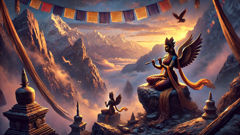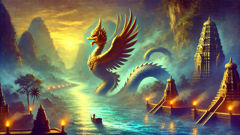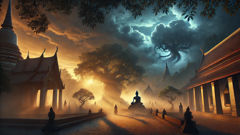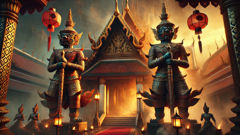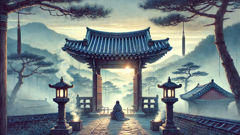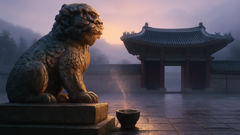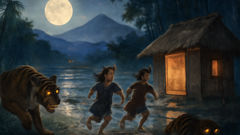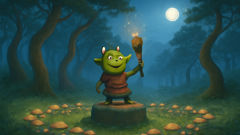Introduction
In the land where gilded spires pierce the sky and the Chao Phraya River glimmers beneath the golden sun, the story of the Ramakien pulses at the very heart of Thai identity. This is a saga woven into temple murals, whispered in market squares, and celebrated in the grand masked dances of khon. The Ramakien is not merely a legend—it is a living tapestry of devotion, valor, and cosmic justice, handed down through generations. It tells of Prince Rama, his unwavering brother Lakshman, the devoted monkey king Hanuman, and the gentle yet steadfast Sita, whose abduction by the ten-headed demon king Tosakan plunges the world into turmoil. Within its verses, every mountain and river of ancient Thailand seems to echo with magic and meaning. From the lush forests of Kanchanaburi to the majestic palaces of Ayutthaya, this epic sweeps across realms—earthly and divine—uniting gods and mortals in a struggle between the forces of darkness and the undying light of virtue. Here, we embark on an immersive retelling that brings the Ramakien to life with cinematic detail, from the thunder of celestial chariots to the quiet courage of a loyal heart. Whether you know these characters as mythic heroes or beloved icons of Thai culture, their story invites you into a world where every trial becomes a lesson, every victory a celebration, and every act of love a promise that goodness will endure.
The Shattered Peace: Tosakan’s Deception and Sita’s Abduction
In the tranquil heart of Ayutthaya’s mythical kingdom, King Dasaratha ruled with wisdom and kindness. His sons—Rama, the virtuous; Lakshman, loyal and fierce; and others—were beloved by all. Rama, heir to the throne, was revered for his integrity and unwavering devotion to dharma. When his stepmother, Kaikeyi, demanded his exile through a twisted boon, Rama accepted his fate with stoic grace. Accompanied by Sita and Lakshman, he journeyed into the wild forests, renouncing royal privilege for an ascetic life. Yet peace was fleeting.
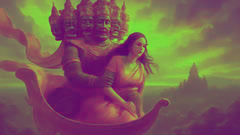
In the shadowy realm of Lanka, the demon king Tosakan seethed with envy and desire. With ten heads and twenty arms, Tosakan’s ambitions were as vast as his cunning. Rumors of Sita’s beauty had reached his ears—a beauty so radiant it was said to charm the gods themselves. Obsessed, Tosakan plotted to claim Sita and break Rama’s spirit. He conjured illusions and dispatched his sorceress sister, Surpanakha, to lure the brothers. Spurned and humiliated by Rama and Lakshman, Surpanakha returned to Tosakan, her wounds fueling his rage. Tosakan devised a plan: his uncle Maricha would transform into a golden deer, dazzling Sita. Entranced by its shimmering pelt, Sita implored Rama to capture it. Reluctant but eager to please her, Rama set off, leaving Lakshman to guard Sita.
Suddenly, Rama’s voice echoed in the distance—an anguished cry for help, cleverly mimicked by Maricha as he fell to Rama’s arrow. Alarmed, Sita insisted Lakshman rush to Rama’s aid, drawing a protective line—the Lakshman Rekha—before leaving. No sooner had Lakshman disappeared than Tosakan, disguised as a weary hermit, approached Sita. She offered food but refused to cross Lakshman’s line. With a flash of demonic power, Tosakan seized her, the earth shuddering as he soared skyward with his prize. Sita’s cries pierced the jungle as Tosakan carried her to his jeweled fortress in Lanka, leaving petals and tears scattered along the path.
Grief-stricken, Rama and Lakshman searched desperately, following traces of Sita’s jewelry and broken bangles. Their journey took them deep into tangled forests and shimmering rivers, where hope flickered like fireflies at dusk. Along the way, they encountered new allies: Sugriva, the exiled monkey king, and Hanuman, whose boundless strength and loyalty would shape the fate of worlds. Rama aided Sugriva in reclaiming his throne from the tyrant Vali; in gratitude, Sugriva pledged the support of his vast monkey army. Hanuman, ever resourceful, leapt across oceans and mountains, vowing to find Sita.
In Lanka’s golden palace, Sita endured Tosakan’s advances with quiet defiance. She clung to memories of Rama and the promise that love, tempered by suffering, would one day triumph over evil. The wind carried her prayers across the sea to Rama’s waiting heart, setting in motion a chain of events that would ignite a war shaking heaven and earth.
The Gathering of Allies: Hanuman’s Leap and the Dawn of War
Rama’s quest transformed as hope was reignited by the wisdom of Jatayu, the noble vulture who, mortally wounded in defending Sita, revealed Lanka’s direction. Guided by clues and new alliances, Rama’s path brought him to the monkey citadel of Kishkindha. There he met Hanuman—a figure of boundless energy, fur as white as jasmine, eyes blazing with purpose. Hanuman knelt before Rama, vowing undying loyalty, his heart moved by Rama’s suffering and Sita’s plight. Sugriva’s monkey hosts assembled with thunderous cheer, swelling the ranks of those resolved to challenge Tosakan’s dominion.
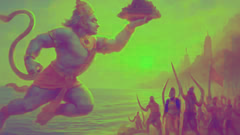
To reach the distant island fortress of Lanka, Hanuman volunteered to make the impossible leap. Standing atop Mount Mahendra, he called upon his divine powers. His form grew immense, casting a colossal shadow over the earth. With a single, breathtaking bound, Hanuman soared above roaring seas, clouds swirling beneath him. Birds scattered, and the sun itself seemed to pause as Hanuman crossed leagues in a heartbeat. He landed unseen in Lanka, its golden walls glittering under an otherworldly sky. Hanuman prowled its streets, blending with moonlight and shadows. He found Sita, frail yet unbroken, in a sacred garden. Presenting Rama’s signet ring, Hanuman pledged deliverance. Sita pressed a jewel into his palm—a token of hope for Rama.
Hanuman’s escape was as dramatic as his entry. Discovered by Tosakan’s minions, Hanuman unleashed chaos, growing in size and strength. He destroyed palaces and gardens, taunted Tosakan, and, when captured, allowed his tail to be set ablaze. Undaunted, he leapt across Lanka’s rooftops, turning fire into a symbol of resistance as he ignited Tosakan’s city before leaping back to Rama. The message was clear: Sita lived and awaited rescue.
With knowledge of Sita’s location and the monkey army at his command, Rama prepared for war. The monkeys engineered a miraculous bridge of floating stones—each stone inscribed with Rama’s name—stretching from the shores of Thailand to Lanka itself. It was a feat blending engineering, faith, and myth, uniting heaven and earth for a single purpose. As dawn broke, Rama’s army surged across the bridge, banners fluttering, drums echoing through the mist.
On Lanka’s battlements, Tosakan gazed out with his ten pairs of eyes, summoning his demon legions—ogres with fangs like ivory scimitars, sorcerers who bent shadows to their will, and monstrous beasts born from nightmares. The stage was set for a battle that would echo through ages: an army of virtue led by Rama, Hanuman, and Sugriva, facing a darkness that threatened to engulf the world.
The Siege of Lanka: Courage, Sacrifice, and the Triumph of Light
The siege of Lanka unfolded beneath storm-dark skies streaked with fire and the clangor of a thousand weapons. Rama’s monkey warriors hurled boulders and uprooted trees as the demon host retaliated with arrows that blazed like comets. Hanuman became a whirlwind of energy—toppling towers, uprooting fortresses, and rescuing wounded allies with supernatural strength. Lakshman fought by Rama’s side, his courage unwavering despite wounds that would have felled lesser men.
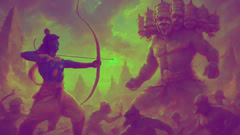
Tosakan’s sorcery was formidable. He conjured illusions, multiplied his heads, and launched enchanted weapons forged in the depths of the underworld. Demonic generals like Indrajit—the master of black magic—brought terror to the battlefield. Indrajit’s arrows rendered Lakshman unconscious, and hope wavered. But Hanuman soared to the Himalayas, tearing up an entire mountain to deliver the life-restoring herb sanjeevani in time to save Lakshman. The armies rallied anew.
As dawn painted Lanka’s spires in crimson and gold, Rama unleashed his full might. Armed with divine weapons granted by the gods, he shattered Tosakan’s chariots and broke through enchanted shields. The clash between Rama and Tosakan was titanic—arrows colliding like thunderbolts, swords flashing with blinding light. For days they battled, the earth itself trembling beneath their fury.
At last, Rama invoked the celestial Brahmastra, a weapon of purity and justice. As it struck Tosakan’s heart, the demon king’s myriad heads fell silent. The darkness that had hung over Lanka dissipated in a rush of wind and sunlight. Sita was freed from captivity, her dignity unblemished by months of ordeal. Yet even now, Rama demanded proof of her chastity—an ordeal by fire. Sita stepped into the flames, emerging untouched as the gods themselves bore witness to her purity.
The war ended not merely in victory, but in restoration—of order, trust, and cosmic balance. Hanuman and the monkey army were honored; Lanka’s throne was restored to Tosakan’s righteous brother. Rama, Sita, and Lakshman journeyed home to Ayutthaya, welcomed by a kingdom ablaze with lamps, their return symbolizing the ultimate triumph of good over evil.
Conclusion
Thus concludes the Ramakien—a saga that has shaped the soul of Thailand for centuries. Its heroes are etched in temple murals, their virtues celebrated in grand festivals and everyday kindnesses. The journey of Prince Rama and his companions is more than a tale of conquest; it’s a meditation on loyalty, forgiveness, and the enduring power of light to conquer darkness. In every act of devotion, every moment of sacrifice, the Ramakien teaches that love and virtue are stronger than even the most fearsome evil. These lessons ripple outward, inspiring hope and unity across generations. As lanterns float along Thai rivers and temple bells chime at dusk, the spirit of Rama, Sita, and Hanuman lives on—reminding us that every struggle holds the promise of renewal and every ending, the seed of a new beginning.

